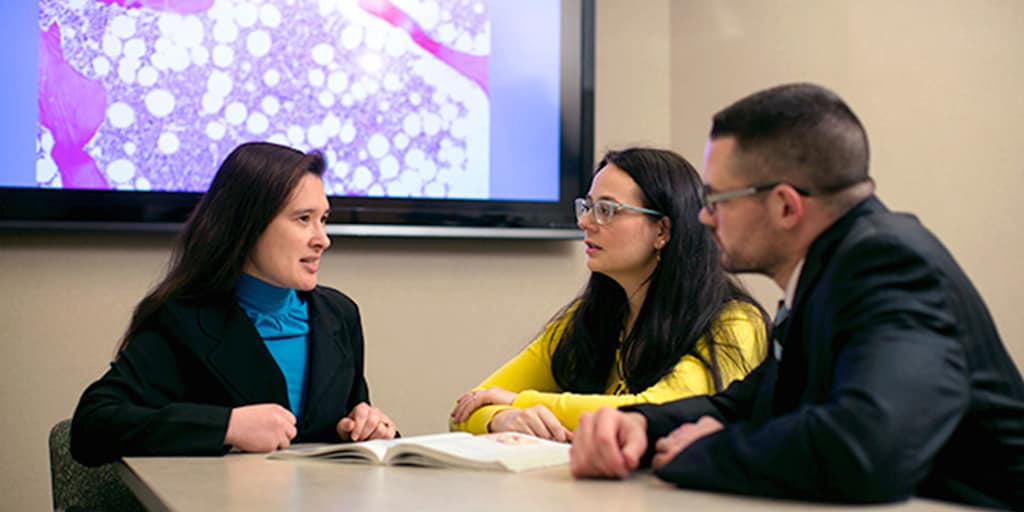Prerequisites and Admission Requirements

Acceptance factors and criteria
The Mayo Clinic M.D.-Ph.D. Program prepares students to translate scientific discoveries into applications that improve patient care. This requires a wide range of skills, aptitudes, and characteristics.
Along with the basic set of prerequisites, the admission committee takes a holistic approach to admissions; meaning, we take into consideration the many factors that make up an applicant. These acceptance factors include:
- Depth and breadth of research experience
- Exposure to and exploration of medicine
- Leadership experience, artistic and athletic endeavors, and work experiences
- Academic performance
- GPA (no minimum GPA requirement; graduate-level coursework and grades are taken into consideration)
- MCAT score/percentile
- Personal statement
- Letters of recommendation
All qualified applicants will receive consideration for education programs without regard to race, color, religion, sex, gender identity, sexual orientation, protected veteran status, or disability status.
After you review the prerequisites and general requirements for admission, learn more about the admissions and application process.
Transfer policy
The Mayo Clinic M.D.-Ph.D. Program does not accept requests for transfer from medical school students either currently or previously enrolled in another medical school program, international or domestic.
The only pathway to matriculation to the Mayo Clinic M.D.-Ph.D. Program is to apply through the American Medical College Application Service (AMCAS).
Prerequisites
Citizenship
At the time of application, applicants must be a(n):
- Citizen of the United States or lawful permanent resident of the United States
- Noncitizen national of the United States
- Asylee
- Refugee
DACA recipients are also eligible to apply.
Foreign nationals
Regardless of immigration status, foreign nationals who do not fit into the categories listed above are eligible for admission to the Mayo Clinic M.D.-Ph.D. program only if the applicant can present, at the time of application, either:
- Proof of eligibility to file the Free Application for Federal Student Aid (FAFSA)
- Proof of eligibility for Canadian provincial or federal financial aid support
Undergraduate degree
All applicants must have a bachelor's or Pharm.D. degree from an accredited college or university in the United States or Canada. A higher degree cannot be substituted for this requirement.
Medical College Admission Test (MCAT)
The Medical College Admission Test (MCAT) is required of all applicants. Scores must be posted to the AMCAS application no later than Oct. 1 in order to be considered for the current application cycle. Only MCAT scores reported within three years of matriculation year are considered in admissions decisions.
Grade Point Average (GPA)
There is not a minimum undergraduate GPA requirement for admission to the Mayo Clinic M.D.-Ph.D. Program. All graduate-level coursework and grades are taken into consideration.
Suggested undergraduate coursework
- It is strongly suggested that applicants have completed one year of coursework with demonstrated competence (B average or above) in biology, chemistry, physics, and calculus.
- Additional coursework in biochemistry, molecular biology, cell biology, and physiology is encouraged.
- Applicants interested in the Biomedical Engineering and Physiology Track are encouraged to have courses in quantitative science and engineering (such as signal processing, computer science, and instrumentation).
AP and IB credits are accepted if they are included in the undergraduate transcript.
Other admissions requirements
Technical standards (nonacademic criteria)
Matriculating students must meet and maintain the following nonacademic criteria (technical standards) to participate in the Medical Scientist Training Program.
Observation
- Students must be able to attend and meaningfully participate in all classroom, small group, and laboratory exercises in the basic medical sciences.
- Students must be able to assess and comprehend the condition of all patients assigned to them for examination, diagnosis, and treatment.
- Such observation and information acquisition require functional auditory and somatic sensations.
Communication
- Students must be able to communicate effectively and sensitively with patients in order to elicit information, describe changes in mood, activity and posture, and assess nonverbal communications.
- Students must be able to effectively and efficiently transmit information to patients, fellow students, faculty, and staff.
- Students must possess required communication skills including speaking, reading, and writing, as well as the observation skills described above.
- Students must be able to communicate their discoveries in English to the scientific community.
Motor
- Students must have sufficient motor function to complete a comprehensive physical examination, carry out diagnostic procedures, provide general care and emergency treatment to patients, and use an electronic medical record.
- Students must have sufficient motor function to perform lab experiments.
Intellectual-conceptual, integrative, and quantitative abilities
- Students must be able to measure, calculate, reason, analyze, and synthesize.
- Students must be able to comprehend three-dimensional relationships and to understand the spatial relationships of structures.
- Students must have the capacity to perform problem-solving skills in a timely fashion.
Behavioral and social attributes
- Students must be able to fully utilize their intellectual abilities, exercise good judgment, and demonstrate behaviors of professionalism.
- Students must demonstrate mature, sensitive, and effective relationships with patients and others. This includes compassion, integrity, respect, concern for others, commitment, and motivation.
- Students must be able to tolerate taxing workloads, function effectively under stress, adapt to changing environments, display flexibility, and learn to function in the face of uncertainties inherent in the clinical problems of many patients.